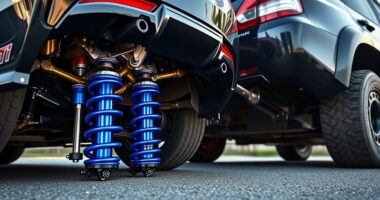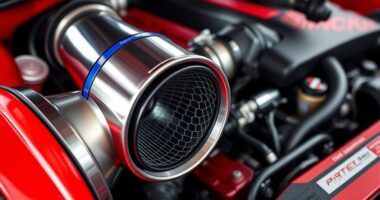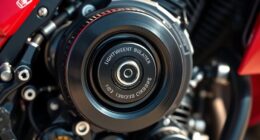In EJ engines, open loop boost control relies on fixed wastegate settings, which can lead to inconsistent boost pressure during changing conditions, while closed loop uses sensors to continuously monitor and adjust boost for peak performance. This means closed loop provides smoother acceleration, better responsiveness, and safer operation by adapting to temperature, load, and altitude variations. If you want to understand how these systems impact engine efficiency and reliability, there’s more to explore below.
Key Takeaways
- Open loop sets fixed boost targets without real-time feedback, while closed loop adjusts boost based on sensor data.
- Closed loop offers more precise boost control, reducing overshoot and lag compared to open loop.
- Open loop systems are simpler and cheaper but less adaptable to changing engine conditions.
- Closed loop enhances engine responsiveness, efficiency, and safety by continuously monitoring actual boost levels.
- Modern turbocharged engines predominantly use closed loop systems for optimal performance and reliability.

Have you ever wondered how turbocharged engines precisely manage boost pressure? It’s a fascinating process that involves balancing power delivery with reliability. When you step on the accelerator, your engine’s turbocharger compresses air entering the cylinders, increasing power. But controlling that boost isn’t as simple as just turning a screw; it involves a sophisticated system to prevent over-boosting and ensure smooth operation. This is where the concepts of open and closed loop boost control come into play, especially in engines with electronic control units (ECUs).
In a basic open loop boost control system, the ECU sets a target boost level based on engine parameters like throttle position and RPM, then commands the wastegate to open accordingly. The wastegate operation—essentially a valve that diverts exhaust gases away from the turbine wheel—regulates boost pressure by controlling how much exhaust energy drives the turbo. In this setup, the wastegate opens at a predetermined level, allowing excess gases to bypass the turbine, preventing boost from climbing too high. However, this method can introduce issues like turbo lag, which is the delay between pressing the accelerator and feeling the turbo’s full effect. Because it relies on fixed settings, the open loop system doesn’t adapt to changing conditions, leading to potential overshoot or undershoot of boost levels, especially during rapid throttle changes or varying ambient conditions.
Closed loop boost control, on the other hand, adds a layer of precision. It uses sensors—most notably a boost pressure sensor—to continuously monitor the actual boost level. The ECU then compares this real-time data to the target boost and adjusts the wastegate operation dynamically. This feedback loop allows for more accurate boost regulation, reducing turbo lag and minimizing fluctuations. When the boost pressure exceeds the desired level, the ECU signals the wastegate to open slightly more, bleeding off excess pressure. If it’s too low, the wastegate remains closed longer. This constant real-time adjustment results in smoother acceleration, better fuel efficiency, and safer operation.
The key advantage of closed loop boost control is its adaptability. It compensates for changes in engine load, altitude, and temperature, maintaining suitable boost pressure under a wide range of conditions. While open loop systems are simpler and cheaper, they lack the finesse of closed loop setups. For performance applications or modern vehicles aiming for efficiency and reliability, closed loop control offers a significant edge. By precisely managing boost through continuous feedback and wastegate operation, it ensures your turbocharged engine delivers power smoothly and safely, making your driving experience more responsive and enjoyable.
Additionally, advancements in sensor technology have further enhanced the effectiveness of closed loop systems, allowing for even more precise control and improved engine performance.
Frequently Asked Questions
How Does Boost Control Impact Engine Reliability?
Boost control affects engine reliability by managing pressure levels, which prevents turbo lag and protects engine parts. Proper wastegate tuning ensures consistent boost, reducing strain and wear on components. When boost is well-regulated, your engine runs smoother and lasts longer, avoiding over-boosting that could cause damage. So, good boost control minimizes risks, improves performance, and helps your engine stay reliable over time.
Can Open and Closed Loop Systems Be Used Together?
You might think combining systems is complex, but hybrid integration makes it seamless. Open and closed loop boost control systems can work together through system compatibility, allowing you to optimize performance and reliability. This integration enables real-time adjustments and stability, giving you better control over engine boost. By leveraging both systems’ strengths, you enhance efficiency without sacrificing precision, making your EJ engine more responsive and dependable under various driving conditions.
What Maintenance Is Required for Boost Control Systems?
For boost control systems, you’ll want to regularly check the wastegate and boost pressure sensors to prevent turbo lag and guarantee smooth operation. Keep the wastegate tuning in ideal condition by inspecting for leaks or sticking components. Also, clean or replace vacuum lines and actuators as needed. Proper maintenance helps your system respond quickly, reduces lag, and keeps your engine running efficiently. Regular checks prevent costly repairs and maintain peak performance.
How Do Boost Control Strategies Vary for Different Engine Types?
You’ll find boost control strategies vary based on engine type. For turbo tuning, you adjust wastegate calibration to enhance boost levels and response. Some engines use open-loop systems for straightforward control, while others employ closed-loop strategies for precise management, improving efficiency and power. You need to tailor your approach to your specific engine, considering factors like boost pressure, response time, and durability, ensuring ideal performance across different setups.
What Are the Signs of Boost Control System Failure?
Your boost control system failing feels like a rocket losing its fuel. You might notice turbo lag taking forever to build boost, or the engine running rough and inconsistent. A wastegate malfunction can cause over-boosting, risking engine damage. Keep an eye out for sudden power drops, unusual noises, or a boost gauge acting erratically. These signs warn you that your boost control system needs urgent attention before things get worse.
Conclusion
In the end, choosing between open and closed loop boost control depends on your driving needs. Did you know that closed loop systems can adjust boost pressure within just milliseconds, improving fuel efficiency and power delivery? If you crave reliability and precise control, closed loop is your best bet. But for simpler setups, open loop offers ease of tuning. Understanding these differences helps you make smarter decisions for your EJ engine’s performance.









